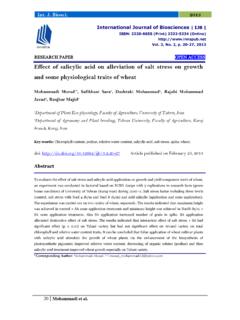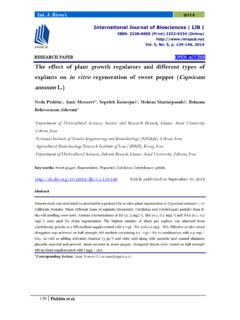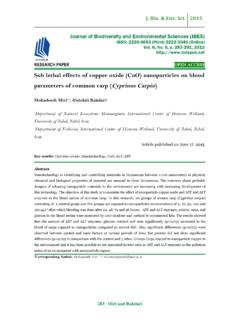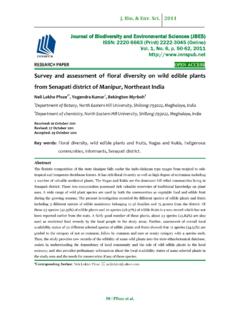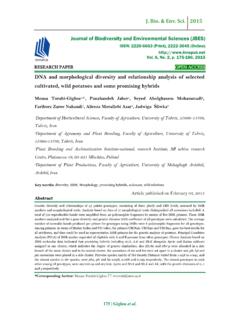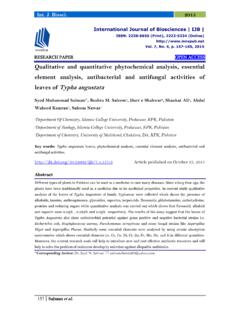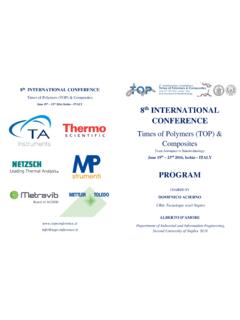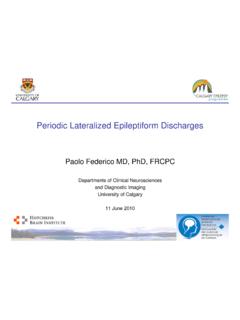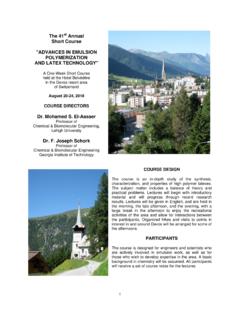Transcription of An overview of lactic acid bacteria - INNSPUB
1 1 | Khalid REVIEW PAPER OPEN ACCESS An overview of lactic acid bacteria Khalisanni Khalid Department of Applied Chemistry, Faculty of Applied Sciences, Universiti Teknologi MARA (UiTM), 40450 Shah Alam, Selangor, Malaysia Received: 02 May 2011 Revised: 14 May 2011 Accepted: 15 May 2011 Key words: Antimicrobial compound, fermentation, lactic acid bacteria (LAB). Abstract lactic acid bacteria (LAB) are renowned for the potential of producing antimicrobial compound and other value added products.
2 Undeniable to concern these probiotic has contributed to the importance of human life. Deserving an attention for its capabilities, this paper will discuss on the general description of lactic acid bacteria , genetics, metabolism and its application to the industries. Corresponding Author: Khalisanni Khalid Journal of Biosciences (IJB) ISSN: 2220-6655 (Print) 2222-5234 (Online) Vol. 1, No. 3, p. 1-13, 2011 2 | Khalid Introduction The term lactic acid bacteria (LAB) was gradually accepted in the beginning of the 20th century (Carol et. al., 2010). Other terms as milk souring and lactic acid producing bacteria had previously been used for the same bacteria causing a slight confusion.
3 This ended with publication of a monograph about lactic acid bacteria written by Orla-Jensen, 1919, a work that had great impact on the systematic of LAB (Axelsson, 1989). Classification of LAB genera was based on morphology, mode of glucose fermentation, growth at certain temperatures, and range of sugar utilization. Even though the taxonomy has been revised since then, characters used by Orla-Jensen are still very important in current classification of LAB. lactic acid bacteria constitute a group of bacteria that have morphological, metabolic and physiological similarities, and they are also relatively closely related phylogenetically.
4 The general description of the bacteria within the group is gram-positive, non-sporulating, non-respiring cocci or rods, which do, through fermentation of carbohydrates, produce lactic acid as their major end product. The common agreement is that there is a core group consisting of four genera; Lactobacillus, Leuconostoc, Pediococcus and Streptococcus. Recent taxonomic revisions have proposed several new genera and the remaining group now comprises the following: Aerococcus, Alloiococcus, Carnobacterium, Dolosigranulum, Enterococcus, Globicatella, Lactococcus, Oenococcus, Tetragenococcus, Vagococcus, and Weissella.
5 Lactobacilli, Carnobacteria and some Weissella are rods while the remaining genera are cocci (Jin et al., 2009). For identification of LAB, phenotypic methods have been most commonly used (Corsetti et. al., 2001). More recently, genetic techniques, such as 16S rDNA sequencing have been developed which allows a more consistent and accurate identification of individual strains (Buddhiman et al., 2008). Determination of short sequences of 16S rDNA is today used as a simple way for species determination of isolates of lactic acid bacteria (Schleifer & Ludwig, 1995).
6 The taxonomy of lactic acid bacteria has been based on the gram reaction and the production of lactic acid from various fermentable carbohydrates. The classification of lactic acid bacteria into different genera is largely based on morphology, mode of glucose fermentation, growth at different temperatures, and configuration of the lactic acid produced, ability to grow at high salt concentrations, and acid or alkaline tolerance. For some of the newly described genera (Pilar et. al., 2008), additional characteristics such as fatty acid composition and motility are used in classification.
7 The measurements of true phylogenetic relationship with rRNA sequencing have aided the classification of lactic acid bacteria and clarified the phylogeny of the group. Most genera in the group form phylogenetically distict group, but some, in particular Lactobacillus and Leuconostoc are very heterogeneous and the phylogenetic cluster do not correlate with the current classification based on phenotypic characters. New tools for classification and identification of lactic acid bacteria are underway (Sascha and Magdalena 2010).
8 The most promising for routine used are nucleic acid probing techniques, partial rRNA gene sequencing using the polymerase chain reaction, and soluble protein patterns. The growth is optimum at pH and the organisms have complex nutritional requirements for amino acids, peptides, nucleotide bases, vitamins, minerals, fatty acids and carbohydrates. lactic acid bacteria are gram-positive usually non-motile, non-spore-forming rods and cocci. They lack the ability to synthesize cytochromes and porphyrins (components of respiratory chains) and therefore cannot generate ATP by creation of a proton gradient.
9 The LAB can only obtain ATP by fermentation, usually of sugars. Since they do not use oxygen in their energy production, lactic acid bacteria happily grow under 3 | Khalid anaerobic conditions, but they can also grow in oxygen's presence. They are protected from oxygen byproducts ( H2O2) because they have peroxidases. These organisms are aerotolerant anaerobes (Michaela et al., 2009). Two main sugar fermentation pathways can be distinguished among lactic acid bacteria . Glycolysis (Embden-Meyerhof pathway) results in almost exclusively lactic acid as end product under standard conditions, and the metabolism is referred to as homolactic fermentation (Derek et al.)
10 , 2009). The 6-phosphogluconate/phosphoketolase pathway results in significant amounts of other end products, such as ethanol, acetate, and CO2 in addition to lactic acid and the metabolism is referred to as heterolactic fermentation. Various growth conditions may significantly alter the end-product formation by some lactic acid bacteria . These changes can be attributed to an altered pyruvate metabolism and/or the use of external electron acceptors such as oxygen or organic compounds. Physiology and morphology Orla-Jensen used a few characters as classification basis: morphology (cocci or rods, tetrad formation), mode of glucose fermentation (homo- or heterofermentation), growth at certain cardinal temperatures ( , 10 C and 45 C), and form of lactic acid produced (D, L, or both) (Kenji et al.

